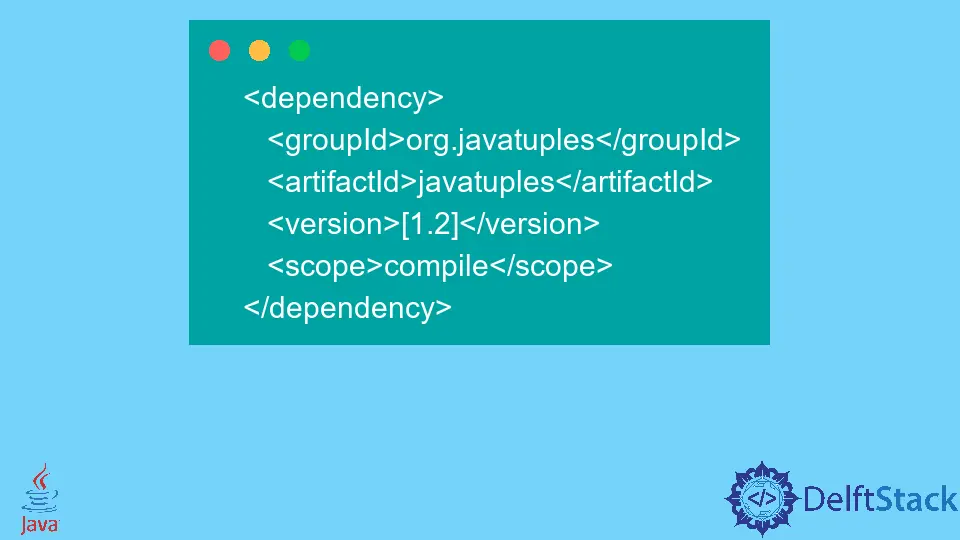Java 中的 JavaTuples
Rupam Yadav
2023年10月12日

元组是一种数据结构,可以存储对象而不需要它们之间的任何关系,但具有共同的动机。Java 不支持元组数据结构,但我们可以使用 JavaTuples 库。
JavaTuples 的特点
- 元组是类型安全的
- 它们是不可变的
- 我们可以遍历元组值
- 它们是可序列化的
- 他们实现了
Comparable<Tuple> - 实现诸如
equals()、hashCode()和toString()之类的方法
JavaTuples 中的元组类
我们最多可以在元组类中使用十个元素。JavaTuples 中的每个元素都有特殊的子类,如下表所述:
| 元素数量(元组大小) | 类名称 | 例子 |
|---|---|---|
| 一 | Unit |
Unit<1> |
| 二 | Pair |
Pair<1,2> |
| 三 | Triplet |
Triplet<1,2,3> |
| 四 | Quartet |
Quartet<1,2,3,4> |
| 五 | Quintet |
Quintet<1,2,3,4,5> |
| 六 | Sextet |
Sextet<1,2,3,4,5,6> |
| 七 | Septet |
Septet<1,2,3,4,5,6,7> |
| 八 | Octet |
Octet<1,2,3,4,5,6,7,8> |
| 九 | Ennead |
Ennead<1,2,3,4,5,6,7,8,9> |
| 十 | Decade |
Decade<1,2,3,4,5,6,7,8,9,10> |
JavaTuples 中的方法
Tuple 类提供了各种方法来执行操作。
| 方法 | 描述 |
|---|---|
equals() |
它用于覆盖 Object 类的 equals 方法的默认实现 |
hashCode() |
返回每个对象的哈希码。 |
toString() |
返回一个字符串表示 |
getSize() |
返回元组的大小 |
getValue() |
返回元组中指定位置的值 |
indexOf() |
返回给定字符串中询问的子字符串的索引。 |
contains() |
检查元组中是否存在元素 |
containsAll() |
检查列表或数组的所有元素是否存在于元组中 |
iterator() |
返回一个迭代器 |
lastIndexOf() |
返回给定字符串中询问的子字符串的最后一个索引。 |
toArray() |
元组到数组 |
toList() |
要列出的元组 |
在 Java 中实现元组
我们导入以下基于 maven 的依赖项以使用 JavaTuples 库。
<dependency>
<groupId>org.javatuples</groupId>
<artifactId>javatuples</artifactId>
<version>[1.2]</version>
<scope>compile</scope>
</dependency>
在示例中,我们实现了上表中的各种元组类,并通过打印它们来获取它们的值。我们在元组中提供不同的数据类型,如 String、Integer、Boolean 等。
我们还创建了一个类 DummyClass,如果它抛出错误,则在元组中传递它的对象。
import org.javatuples.*;
public class JavaTuplesExample {
public static void main(String[] args) {
Unit<String> unitTuple = new Unit<>("First Tuple Element");
Pair<String, Integer> pairTuple = new Pair<>("First Tuple Element", 2);
Triplet<String, Integer, Boolean> tripletTuple = new Triplet<>("First Tuple Element", 2, true);
Quartet<String, Integer, Boolean, String> quartetTuple =
new Quartet<>("First Tuple Element", 2, true, "Fourth Tuple Element");
Quintet<String, Integer, Boolean, String, Integer> quintetTuple =
new Quintet<>("First Tuple Element", 2, true, "Fourth Tuple Element", 5);
Sextet<String, Integer, Boolean, String, Integer, DummyClass> sextetTuple =
new Sextet<>("First Tuple Element", 2, true, "Fourth Tuple Element", 5, new DummyClass());
Septet<String, Integer, Boolean, String, Integer, DummyClass, Integer> septetTuple =
new Septet<>(
"First Tuple Element", 2, true, "Fourth Tuple Element", 5, new DummyClass(), 7);
Octet<String, Integer, Boolean, String, Integer, DummyClass, Integer, String> octetTuple =
new Octet<>("First Tuple Element", 2, true, "Fourth Tuple Element", 5, new DummyClass(), 7,
"Eight Tuple Element");
Ennead<String, Integer, Boolean, String, Integer, DummyClass, Integer, String, Integer>
enneadTuple = new Ennead<>("First Tuple Element", 2, true, "Fourth Tuple Element", 5,
new DummyClass(), 7, "Eight Tuple Element", 9);
Decade<String, Integer, Boolean, String, Integer, DummyClass, Integer, String, Integer, String>
decadeTuple = new Decade<>("First Tuple Element", 2, true, "Fourth Tuple Element", 5,
new DummyClass(), 7, "Eight Tuple Element", 9, "Tenth Tuple Element");
System.out.println(unitTuple);
System.out.println(pairTuple);
System.out.println(tripletTuple);
System.out.println(quartetTuple);
System.out.println(quintetTuple);
System.out.println(sextetTuple);
System.out.println(septetTuple);
System.out.println(octetTuple);
System.out.println(enneadTuple);
System.out.println(decadeTuple);
}
}
class DummyClass {}
输出:
[First Tuple Element]
[First Tuple Element, 2]
[First Tuple Element, 2, true]
[First Tuple Element, 2, true, Fourth Tuple Element]
[First Tuple Element, 2, true, Fourth Tuple Element, 5]
[First Tuple Element, 2, true, Fourth Tuple Element, 5, DummyClass@254989ff]
[First Tuple Element, 2, true, Fourth Tuple Element, 5, DummyClass@5d099f62, 7]
[First Tuple Element, 2, true, Fourth Tuple Element, 5, DummyClass@37f8bb67, 7, Eight Tuple Element]
[First Tuple Element, 2, true, Fourth Tuple Element, 5, DummyClass@49c2faae, 7, Eight Tuple Element, 9]
[First Tuple Element, 2, true, Fourth Tuple Element, 5, DummyClass@20ad9418, 7, Eight Tuple Element, 9, Tenth Tuple Element]
作者: Rupam Yadav
Rupam Saini is an android developer, who also works sometimes as a web developer., He likes to read books and write about various things.
LinkedIn